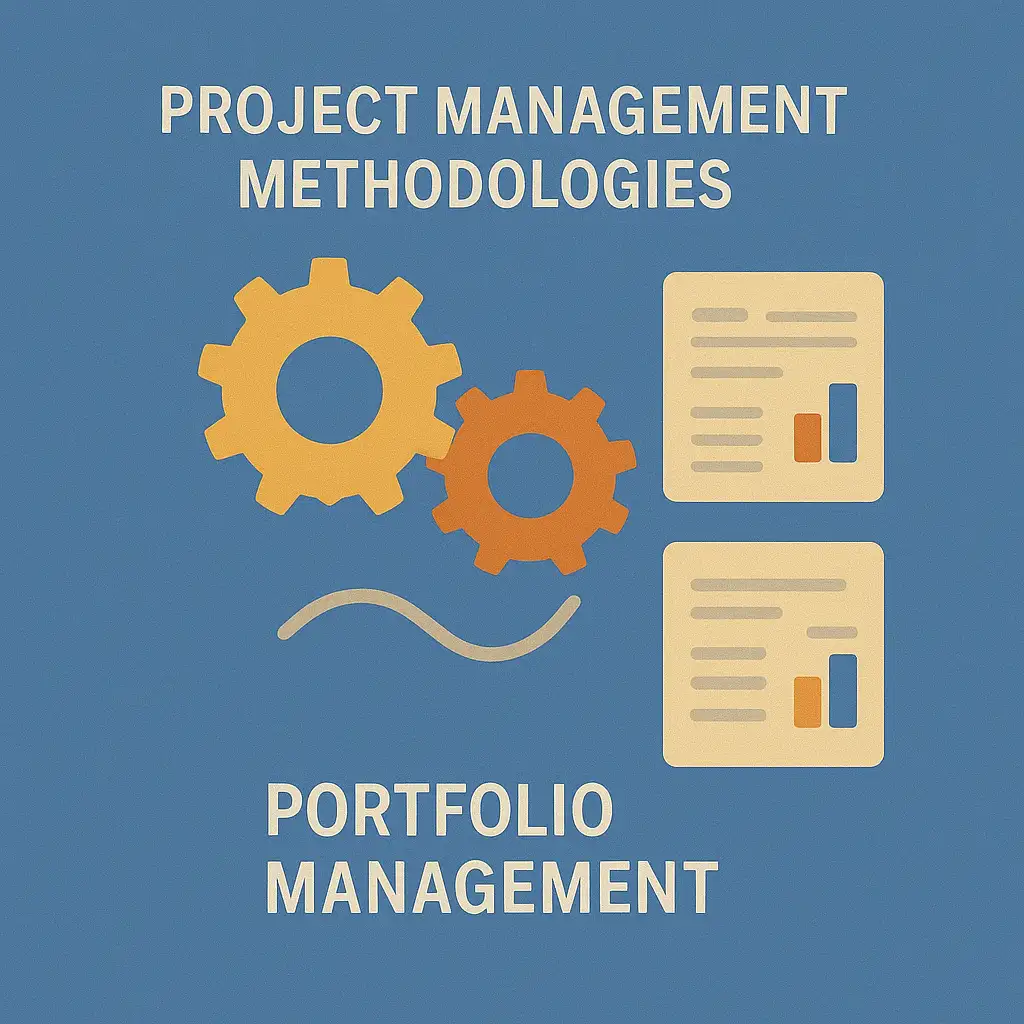Introduction
The concepts of project management and portfolio management play pivotal roles, each serving distinct yet interconnected purposes.
Defining Project Management and Portfolio Management
Project management is the discipline that involves planning, executing, and closing specific projects, ensuring they are completed within defined constraints such as time, budget, and quality. It focuses on achieving the objectives of individual projects, which can vary widely in scope and complexity. On the other hand, portfolio management takes a broader view, encompassing the selection, prioritization, and oversight of a collection of projects and programs. Its primary aim is to align these initiatives with the strategic goals of the organization, ensuring that resources are allocated effectively to maximize overall value and achieve long-term objectives.
Significance of Understanding the Interplay
Understanding the interplay between project management and portfolio management is crucial for project management professionals. This knowledge allows for better alignment of individual project goals with the overarching strategic objectives of the organization. By recognizing how projects fit into the larger portfolio, professionals can make informed decisions that enhance resource allocation, risk management, and overall project success. This synergy not only improves project outcomes but also contributes to the organization’s ability to adapt to changing market conditions and strategic priorities.
Focus on Methodologies and Their Effects on Outcomes
The methodologies employed in both project and portfolio management significantly influence the outcomes of initiatives. Different methodologies, whether agile, waterfall, or hybrid approaches, can affect how projects are planned, executed, and monitored. For instance, agile methodologies may foster flexibility and rapid response to change, which can be particularly beneficial in dynamic environments. Conversely, traditional methodologies may provide a structured framework that ensures thorough planning and risk assessment. By exploring these methodologies and their effects on outcomes, project management professionals can better understand how to optimize their practices to achieve desired results within their portfolios.
Understanding Project Management
Project management is a structured approach to planning, executing, and closing projects, ensuring that specific goals are met within defined constraints such as time, budget, and resources. It encompasses a variety of methodologies, each with its own principles and practices that can significantly influence project outcomes. Here are the core principles and popular methodologies in project management, along with their impact on project execution and success.
Core Principles of Project Management
- Defined Objectives: Successful project management begins with clear, measurable objectives that guide the project from initiation to completion. This clarity helps in aligning the project with organizational goals and stakeholder expectations.
- Stakeholder Engagement: Engaging stakeholders throughout the project lifecycle is crucial. Their input and feedback can shape project direction and ensure that the final deliverable meets their needs.
- Resource Management: Effective allocation and management of resources—human, financial, and material—are essential for project success. This includes planning for resource availability and optimizing their use.
- Risk Management: Identifying, assessing, and mitigating risks is a fundamental aspect of project management. A proactive approach to risk can prevent potential issues from derailing the project.
- Continuous Improvement: Learning from past projects and incorporating feedback into future planning is vital for enhancing project management practices and outcomes.
Popular Project Management Methodologies
- Agile: Agile is an iterative approach that emphasizes flexibility and customer collaboration. It allows teams to adapt to changes quickly and deliver incremental value through short development cycles known as sprints. Agile methodologies, such as Scrum and Kanban, are particularly effective in dynamic environments where requirements may evolve.
- Waterfall: The Waterfall methodology is a linear and sequential approach where each phase must be completed before the next begins. This method is best suited for projects with well-defined requirements and minimal expected changes, such as construction or manufacturing projects.
- Scrum: A subset of Agile, Scrum focuses on delivering small, functional pieces of a project in short time frames. It involves roles such as the Scrum Master and Product Owner, and emphasizes regular feedback and team collaboration.
- Lean: Lean project management aims to maximize value by minimizing waste. It focuses on delivering more with less by streamlining processes and improving efficiency.
- Six Sigma: This methodology emphasizes quality control and process improvement through data-driven decision-making. It aims to reduce defects and variability in processes, leading to higher quality outcomes.
Influence of Methodologies on Project Execution and Success
The choice of project management methodology can significantly impact how projects are executed and their overall success. Here are some ways methodologies influence outcomes:
- Flexibility vs. Structure: Agile methodologies provide flexibility, allowing teams to respond to changes quickly, which can lead to higher customer satisfaction. In contrast, Waterfall offers a structured approach that can be beneficial for projects with fixed requirements, ensuring thorough documentation and planning.
- Team Collaboration: Methodologies like Scrum foster collaboration and communication among team members, which can enhance team dynamics and lead to more innovative solutions. This collaborative environment can also improve problem-solving capabilities.
- Risk Mitigation: Agile’s iterative nature allows for early detection of issues, enabling teams to address risks promptly. Conversely, Waterfall’s upfront planning can help identify potential risks early in the project lifecycle, although it may not adapt as easily to unforeseen changes.
- Outcome Measurement: Different methodologies have varying approaches to measuring success. Agile focuses on delivering value incrementally, while Waterfall emphasizes meeting predefined project milestones and deliverables.
Understanding Portfolio Management
Portfolio management is a strategic approach that focuses on overseeing a collection of projects and programs to achieve specific organizational goals. Unlike project management, which is concerned with the execution and success of individual projects, portfolio management aims to align these projects with the broader strategic objectives of the organization. The primary objectives of portfolio management include:
- Maximizing Return on Investment (ROI): Ensuring that the selected projects contribute positively to the organization’s financial performance.
- Resource Optimization: Effectively allocating resources across various projects to enhance efficiency and minimize waste.
- Risk Management: Identifying and managing risks at the portfolio level to ensure that the organization can achieve its strategic goals without significant setbacks.
- Strategic Alignment: Ensuring that all projects within the portfolio are aligned with the organization’s vision and strategic direction, thereby enhancing overall coherence and effectiveness [2][3][13].
Relationship Between Projects and Portfolios
The relationship between projects and portfolios is fundamental to understanding how organizations manage their initiatives. Projects are the individual efforts undertaken to create specific deliverables, while portfolios consist of multiple projects grouped together based on strategic objectives. This relationship can be summarized as follows:
- Integration: Projects are selected and prioritized based on their alignment with the portfolio’s strategic goals. This means that not all projects are created equal; some may be more critical to the organization’s success than others.
- Performance Measurement: Portfolio management provides a framework for evaluating the performance of individual projects within the context of the overall portfolio. This allows organizations to make informed decisions about resource allocation and project continuation or termination [4][15].
- Holistic View: By managing projects as part of a portfolio, organizations can gain a comprehensive view of their initiatives, enabling better decision-making and strategic planning [6][9].
Key Methodologies in Portfolio Management
Several methodologies guide portfolio management practices, each offering unique frameworks and tools to enhance effectiveness. Some of the key methodologies include:
- Management of Portfolios (MoP): This methodology provides a structured approach to managing a portfolio of projects and programs, focusing on the selection, prioritization, and control of projects to achieve strategic objectives. MoP emphasizes the importance of governance and stakeholder engagement in the decision-making process [1][5].
- Project Portfolio Management (PPM): PPM takes a high-level view of all organizational projects, focusing on maximizing the value of the portfolio as a whole. It involves continuous monitoring and adjustment of projects to ensure alignment with changing business goals and market conditions [6][7].
- Agile Portfolio Management: This approach integrates agile principles into portfolio management, allowing organizations to be more responsive to change. It emphasizes flexibility, iterative progress, and stakeholder collaboration, which can lead to improved outcomes in dynamic environments [3][15].
The Interplay Between Methodologies and Outcomes
The methodologies employed can significantly influence the outcomes of portfolio management. Understanding this interplay is crucial for project management professionals aiming to optimize their portfolio performance. Here are some key points to consider:
- Project Selection Methodologies and Portfolio Performance: The choice of project selection methodologies directly impacts the performance of a portfolio. Effective selection processes ensure that projects align with strategic objectives, thereby enhancing overall portfolio value. For instance, methodologies that prioritize projects based on their potential return on investment (ROI) or strategic fit can lead to more successful outcomes by ensuring that resources are allocated to initiatives that drive the organization’s goals forward. This alignment is essential for maximizing the benefits derived from the portfolio as a whole [2][12].
- Role of Methodology in Resource Allocation and Prioritization: Different project management methodologies dictate how resources are allocated and how projects are prioritized within a portfolio. For example, traditional methodologies often emphasize upfront planning and resource allocation based on detailed project scopes. In contrast, Agile methodologies promote flexibility and iterative resource allocation, allowing teams to adapt to changing project needs and priorities. This adaptability can lead to more efficient use of resources and improved responsiveness to market demands, ultimately enhancing portfolio performance [3][4][12].
- Impacts of Agile vs. Traditional Methodologies on Portfolio Success: The choice between Agile and traditional methodologies can have profound effects on portfolio success. Agile methodologies, characterized by their iterative approach and focus on customer feedback, can lead to faster delivery times and increased stakeholder satisfaction. This responsiveness can enhance the overall success of the portfolio by ensuring that projects remain relevant and aligned with user needs. Conversely, traditional methodologies may provide a more structured approach, which can be beneficial for projects requiring extensive documentation and regulatory compliance. However, this rigidity can sometimes hinder responsiveness and adaptability, potentially impacting the portfolio’s ability to achieve its strategic objectives [4][6][12].
Best Practices for Integrating Project and Portfolio Management
Integrating project management methodologies with portfolio management is essential for achieving strategic objectives and maximizing resource utilization. Here are some actionable recommendations for professionals looking to enhance this integration:
1. Aligning Project Management Methodologies with Portfolio Objectives
- Strategic Alignment: Ensure that project management practices are directly aligned with the overall goals of the portfolio. This involves selecting projects that not only meet immediate needs but also contribute to long-term strategic objectives. By prioritizing projects that align with business strategy, organizations can focus on high-value work and improve overall project performance [6][11].
- Utilize Frameworks for Prioritization: Implement frameworks such as the Eisenhower Matrix or Value vs. Complexity analysis to evaluate and prioritize projects within the portfolio. This helps in making informed decisions about which projects to pursue based on their alignment with strategic goals and resource availability [9][11].
2. Importance of Stakeholder Engagement and Communication
- Foster Effective Communication: Establish clear communication channels among stakeholders involved in both project and portfolio management. Regular updates and feedback loops can help ensure that all parties are aligned and informed about project progress and portfolio changes [4][5].
- Engage Stakeholders Early: Involve stakeholders from the outset of the project and portfolio planning process. Their insights can provide valuable perspectives that enhance decision-making and ensure that projects meet the needs of the organization [4][6].
3. Emphasizing Continuous Improvement and Adaptation
- Incorporate Agile Methodologies: Adopting agile practices can facilitate flexibility and responsiveness to changing project requirements. This approach allows teams to adapt their methodologies based on real-time feedback and evolving business needs, ultimately leading to better project outcomes [7][8].
- Regularly Review and Adjust Methodologies: Establish a routine for assessing the effectiveness of both project and portfolio management methodologies. Continuous improvement should be a core principle, allowing organizations to refine their processes and adapt to new challenges and opportunities [8][11].
By implementing these best practices, project management professionals can effectively integrate methodologies that enhance both project and portfolio outcomes, leading to improved performance and strategic alignment.
Conclusion
In project management, understanding the interplay between project management methodologies and portfolio management is crucial for achieving strategic objectives. The distinction between project management, which focuses on the execution of individual projects, and portfolio management, which oversees a collection of projects aligned with organizational goals, highlights the need for a cohesive approach. This synergy ensures that resources are allocated effectively and that projects contribute to the broader business strategy, ultimately enhancing overall performance and value creation [1][2].
As project management professionals, it is essential to regularly assess the methodologies employed within your organization. Different methodologies—be it traditional, agile, or hybrid—can significantly influence project outcomes and the success of the portfolio as a whole. By evaluating how these methodologies align with your strategic goals, you can identify areas for improvement and optimize your project selection and execution processes [3][4].
Moreover, the landscape of project and portfolio management is ever-evolving, necessitating a commitment to continuous learning and improvement. Engaging with new research, attending workshops, and participating in professional networks can provide valuable insights into emerging trends and best practices. This proactive approach not only enhances individual competencies but also contributes to the overall maturity of project management practices within your organization [5][6].
Find out more about Shaun Stoltz https://www.shaunstoltz.com/about/.
This post was written by an AI and reviewed/edited by a human.



